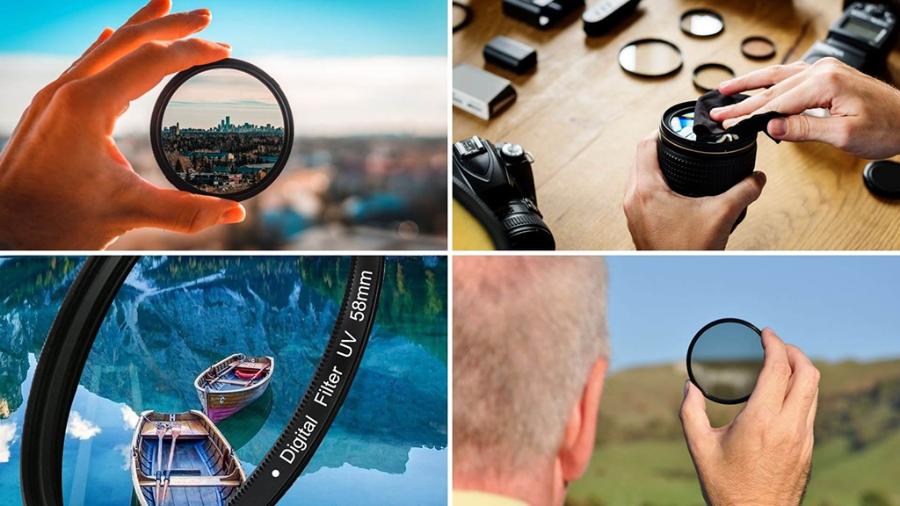Best Selling Products
Instructions for Using Optimal Light Reducing Filters When Taking Landscape Photos
Nội dung
- 1. What is a Light Reducing Filter?
- 2. Popular Types of Light Reducing Filters
- 2.1. ND8, ND16, ND32
- 2.2. ND64, ND1000
- 2.3. Variable ND Filter
- 3. Why Are Light Reducing Filters Important When Taking Landscape Photography?
- 3.1. Create Smooth Motion Effects
- 3.2. Light Control in Bright Conditions
- 3.3. Helps You Use Slow Shutter Speeds
- 4. How to Use a Light Reducing Filter When Taking Landscape Photos
- 4.1. Choose the Right Type of Filter
- 4.2. Adjusting Camera Parameters
- 4.3. Check Vignetting Status
- 5. Notes When Using Light Reducing Filters
- 5.1. Use Variable ND Filters Carefully
- 5.2. Store Filters Carefully
- 5.3. Shooting in Manual Mode
- 6. Conclusion
Learn how to use neutral density filters in landscape photography to control light and create beautiful, sharp photos. How to choose the right filter and the necessary techniques.

When taking landscape photos, light is always an important factor that directly affects the quality of the photo. Especially in strong light conditions such as at noon or when taking outdoor scenes with clear blue skies, using a ND Filter will help you control the amount of light entering the camera, avoiding overexposure or overexposure, while allowing you to use a slower shutter speed to create a smooth effect for moving objects, such as flowing water or drifting clouds. In this article, sadesign will explore with you how to use a ND filter to effectively take landscape photos, techniques to improve photo quality, and how to choose the right filter for your photography needs.
1. What is a Light Reducing Filter?
A neutral density (ND) filter, also known as a light-reducing filter, is an important accessory in photography and videography. Its main function is to reduce the amount of light entering the lens without changing the overall color of the image. This allows the user to have greater control over parameters such as aperture, shutter speed, or ISO in bright light conditions.
.jpg)
Low-light filters are often used to create motion blur effects in scenes such as waterfalls and streams, or to maintain a shallow depth of field in daylight environments without overexposing the image. They are an indispensable tool for professional photographers and filmmakers who need to optimize image quality in complex lighting situations.
2. Popular Types of Light Reducing Filters
There are several types of light-reducing filters available on the market today, with varying degrees of light reduction. These filters are classified primarily based on the number of “Stops” they reduce. The higher the number of Stops, the more light the filter reduces.
2.1. ND8, ND16, ND32
Common types of light-reducing filters today include ND8, ND16 and ND32, which are widely used in the field of professional photography and filming. These filters help reduce the amount of light entering the lens without changing the color of the image, thereby supporting more effective exposure control in strong lighting conditions.
ND8 reduces light by 3 stops, ND16 reduces light by 4 stops, and ND32 reduces light by 5 stops, suitable for different creative needs, from creating smooth effects for water movement to shooting with large apertures in harsh lighting environments. Choosing the right filter will contribute to improving the quality and artistry of the work.
.jpg)
ND8 : Reduces light by about 3 Stops.
ND16 : Reduces light by about 4 Stops.
ND32 : Reduces light by about 5 Stops.
These filters are often suitable for scenes with moderate lighting or when you need to create a gentle motion effect in the scene such as flowing water.
2.2. ND64, ND1000
A neutral density (ND) filter is an important tool in photography and videography, helping to control the amount of light entering the lens without affecting the color of the image. The two most common ND filters today are ND64 and ND1000. ND64 filters are often used in bright light conditions, such as landscape photography or outdoor portraits, to reduce light by 6 stops, creating a smooth effect for flowing water or blurring motion.
Meanwhile, the ND1000 filter is capable of reducing up to 10 stops of light, suitable for situations that require long exposures such as taking artistic photos with floating cloud effects or completely blurring moving objects. Choosing the right filter depends on the purpose of use and specific lighting conditions, ensuring optimal results for photography or filming.
ND64 : Reduces light by about 6 Stops.
ND1000 : Reduces light by about 10 Stops.
These filters are ideal for landscape photography in very bright light conditions, such as when shooting at midday, or when you want to create long, smooth effects on moving subjects such as waterfalls, clouds or ocean waves.
2.3. Variable ND Filter
Variable ND filters allow you to adjust the amount of light reduction as desired, from 2 Stops to 10 Stops depending on the product. This type of filter is extremely convenient when you need to change the level of light reduction quickly without having to change the filter. However, you need to pay attention to the phenomenon of "vignetting" (darkness around the corners of the image) when using variable ND filters.
3. Why Are Light Reducing Filters Important When Taking Landscape Photography?
.jpg)
ND filters are especially important when you are shooting landscapes because they allow you to control the light precisely. Specifically, the biggest benefits of using ND filters in landscape photography are:
3.1. Create Smooth Motion Effects
One of the most common uses of ND filters in landscape photography is to create a smooth motion effect for moving objects such as flowing water, clouds, or ocean waves. By using an ND filter, you can reduce the brightness and extend the exposure time, thereby creating the effect of softening water, clouds, and blurring moving objects.
3.2. Light Control in Bright Conditions
In bright light conditions such as midday, when shooting outdoor landscapes, using an ND filter will help you reduce the light entering the camera without changing other factors. This allows you to use camera parameters such as larger apertures or slower shutter speeds without blowing out the light.
3.3. Helps You Use Slow Shutter Speeds
Another reason why many photographers love ND filters is the ability to use slower shutter speeds. This allows you to create smooth motion blur effects on moving subjects like waterfalls, ocean waves, or clouds. Slow shutter speeds also allow for brighter images in low light without having to increase the ISO, which reduces image quality.
4. How to Use a Light Reducing Filter When Taking Landscape Photos
.jpg)
A neutral density (ND) filter is an important tool in landscape photography, helping to control light and create dramatic images. Using this filter, you can reduce the amount of light entering the lens without changing the color of the image, allowing you to use slower shutter speeds to create smooth effects for flowing water, moving clouds, or other dynamic subjects.
4.1. Choose the Right Type of Filter
Choosing the right ND filter for your lighting conditions is important. If you are shooting in moderate light, an ND8 or ND16 filter will be ideal. However, if you are shooting during very bright hours, use an ND64 or ND1000 filter to effectively reduce the light.
4.2. Adjusting Camera Parameters
When using an ND filter, you will need to adjust your camera settings to achieve the desired results. Make sure you check factors such as ISO , aperture , and shutter speed to match the amount of light reduction the filter provides. For example, if you are using an ND1000 filter (10 Stops of light reduction), you will need to slow down your shutter speed or increase your aperture to compensate for the reduced amount of light.
4.3. Check Vignetting Status
When using ND filters, especially variable ND filters, you may experience vignetting – a phenomenon where the corners of the image darken relative to the center. This can degrade the quality of your image if left unchecked. To avoid vignetting, make sure your filter is the right size for your lens and check the position of the filter when changing the intensity.
5. Notes When Using Light Reducing Filters
.jpg)
When using a light-reducing filter, users need to note some important points to ensure efficiency and image quality.
5.1. Use Variable ND Filters Carefully
Variable ND filters can be very convenient when you need to adjust the amount of light reduction while shooting. However, if you are not careful, they can cause an “X” effect in the corners of the image when used with extremely strong light reduction levels. To avoid this, you should experiment and use moderate, not too strong, levels.
5.2. Store Filters Carefully
Filters are sensitive and easily scratched. Always store your filters in a special bag and clean them with a soft cloth after each use. This will keep your filters in the best condition and will not reduce the quality of your photos.
5.3. Shooting in Manual Mode
To get the best results when using an ND filter, it is recommended that you shoot in Manual mode. This gives you full control over all parameters such as shutter speed, aperture and ISO to get the best results!
6. Conclusion
ND filters are an indispensable tool in the professional photographer's toolbox, especially in landscape photography. Using ND filters not only helps you control light but also gives you the opportunity to create beautiful photos with smooth effects for moving subjects. By choosing the right filter and applying the right editing techniques, you can easily enhance the quality of your photos, thereby creating personal works of art. Try using ND filters today to explore the world of landscape photography in a new and more creative way!












































